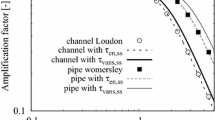Abstract
We have made simple observations of the ascent of a buoyant fluid through a pipe formed in a denser and more viscous fluid that can deform viscously and allow the pipe radius to change. There is no wall between the two fluids, and the Reynolds number is small in both fluids. If the buoyant fluid is supplied at a uniform rate, the system exhibits uniform Poiseuille flow. The response of the system to fluctuations in the rate of supply of the buoyant fluid is to form local maxima in the pipe radius that ascend as solitary waves. Larger-amplitude waves can catch up and collide with smaller waves and, to a good approximation, both waves recover their original form and amplitude after such a collision. Periodic wavetrains are formed when the supply of fluid to the pipe is increased and sustained at a higher rate. These observations gain significance because the system is analogous to that of one-dimensional buoyancy-driven porous flow in a viscous matrix. The experiment may be regarded as a laboratory analogue for studying some aspects of the equations governing porous flow. The observed behaviour is consistent with recent theoretical and computational studies1,2, which have focused on the problem of magma migration in the Earth. The behaviour we observe will, however, arise in other systems governed by the same mechanics. The existence of solitary waves in such systems means that the responses to transient changes in the porosity or the supply of fluid could be long-lived.
Similar content being viewed by others
References
Scott, D. R. & Stevenson, D. J. Geophys. Res. Lett. 11, 1161–1164 (1984).
Richter, F. M. & McKenzie, D. P. J. Geol. 92, 729–740 (1984).
McKenzie, D. P. J. Petrol. 25, 713–765 (1984).
Waff, H. S. & Bulau, J. R. J. geophys. Res. 84, 6109–6114 (1979).
Cooper, R. F. & Kohlstedt, D. L. Tectonophysics 107, 207–233 (1984).
McKenzie, D. P. Earth planet. Sci. Lett. 74, 81–91 (1985).
Whitehead, J. A. & Luther, D. S. J. geophys. Res. 80, 705–717 (1985).
Whitehead, J. A. Geophys. J. R. astr. Soc. 70, 415–433 (1982).
Huppert, H. E., Sparks, R. S. J., Whitehead, J. A. & Hallworth, M. A. J. geophys. Res. (in the press).
Scott, D. R. & Stevenson, D. J. J. geophys. Res. (in the press).
Barcilon, V. & Richter, F. M. J. Fluid Mech. (in the press).
Olson, P. & Christensen, U. J. geophys. Res. (submitted).
Author information
Authors and Affiliations
Rights and permissions
About this article
Cite this article
Scott, D., Stevenson, D. & Whitehead, J. Observations of solitary waves in a viscously deformable pipe. Nature 319, 759–761 (1986). https://doi.org/10.1038/319759a0
Received:
Accepted:
Issue Date:
DOI: https://doi.org/10.1038/319759a0
- Springer Nature Limited
This article is cited by
-
Spontaneous formation of fluid escape pipes from subsurface reservoirs
Scientific Reports (2018)
-
Sawtooth wave-like pressure changes in a syrup eruption experiment: implications for periodic and nonperiodic volcanic oscillations
Bulletin of Volcanology (2018)
-
Reykjanes 'V'-shaped ridges originating from a pulsing and dehydrating mantle plume
Nature (2001)
-
Compaction waves as phase transitions
Acta Mechanica (1994)





